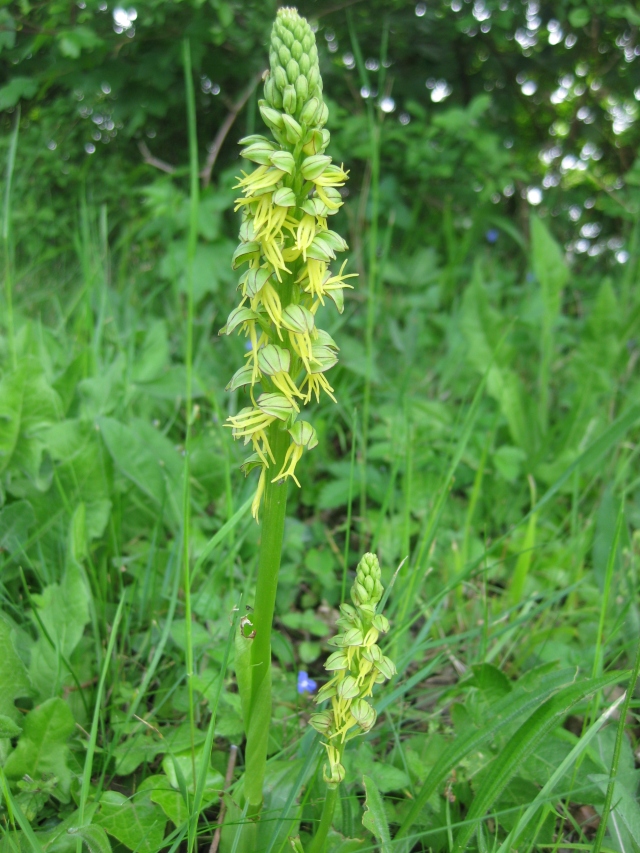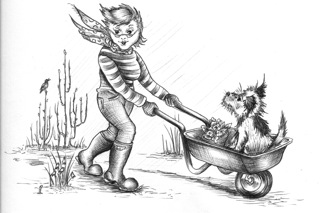Aceras anthropophorum: The Man Orchid is very rare in Britain and it is classified as endangered. There are only four sites in Suffolk where it can be found and three of these sites are on Roadside Nature Reserves.

Last Sunday was a red letter day for me because I have been searching for this orchid for the last couple of weeks in the areas where it is supposed to grow, without any success . On Sunday, I got lost on a narrow country lane and I stopped when I saw this marker sign.

It is always worth having a look when you find these signs as they are there to protect rare flora or a stretch of verge which is species rich. I couldn’t believe my luck, I had got lost and found exactly what I was looking for, by accident; the elusive Man Orchid!

If you look at it carefully you can see how it got its name. The flowers look like little men, with the petals and sepals forming the head and the dangling torso and limbs are formed by the lobes of the labellum.
Sometimes the flowers are tinged with red but as you see, this one is almost uniformly yellow apart from a narrow red stripe. It grows in chalk and limestone grassland but I don’t think it has ever been common in Suffolk. In any case, most of its habitat was lost when chalk pastures were ploughed up.
Suffolk was the first county to introduce Roadside Nature Reserves which are the last refuge for some of our rarest wild flowers. Many other counties now have them too. It is sad that our flower rich meadows have been reduced to roadside verges but at least they are now protected. Many orchids and other rare plants were lost due to the indiscriminate use of weed killers in the 60s. Now these verges are managed and they are cut at the appropriate times to give the plants the best chance to set seed and survive. The Man Orchid is pollinated by beetles and sawflies but it never sets much seed and so it is always going to be rare.
I am joining in with Gail’s monthly meme Wildflower Wednesday which is a wonderful way to share our native flora. If you love wild flowers why don’t you join in on the fourth Wednesday of each month? If you pop over to clayandlimestone you can see other peoples’ photographs of their native wild flowers. I follow several blogs where people love and value their local wild flowers, so please join in.


The date had escaped me! I will be late for Wildflower Wednesday. This is brilliant, I have not seen this species before and its a great description. The little men remind me of squid.
I don’ t think it matters if you are late but it would be great if you could join in.
This is lovely, how marvellous that your county protects your roadside verges, the orchids I found near our village are just common orchids, but at least they are safe for now. Hopefully more Councils will realise that it costs them a lot less if they leave they roadsides to flower and set seed!
The council doesn’ t protect all the verges, just the ones which are species rich. It is actually a team effort with Suffolk County Council collaborating with their grass cutting contractors, Parish Councils and volunteers who act as wardens. Anyone can volunteer I have expressed an interest in orchids and have been asked to count and monitor them in my locality.
Why don’ t you chivvy your Council to adopt the Roadside Nature Reserve Scheme?
Well done to Suffolk for protecting those few refuges of wild flowers left! Next holiday there, I’ll watch out for the signs. Your little men look like aliens to me – something from Close Encounters! But Alien Orchid doesn’t have same ring to it!
There are other counties with protected verges now. It is worth keeping an eye out for them.
You are right the head does look rather alien -like.
What a find! They are so cute and a great yellow color. It’s good to see the efforts being taken in your area to preserve wildflowers and native plants.
I was thrilled to find them as I have never seen them in this country before.
How wonderful to see this rare orchid! I wish I could have been with you. I’m very fond of a hike, especially if it includes wildflowers. I must not have much of an imagination, though, because I cannot see the little man!
Well I admit he hasn’ t got much of a head but he has a dangling torso and arms and legs.
What a great post! I couldn’t see the little man at first, but spotted “him” with your excellent explanation. The Roadside Nature Reserves is such a great idea. Thank you for teaching about this rare plant.
Thank you for visiting and commenting Tina.
An enjoyable, and interesting, post. xx
Cheers Flighty.
Great post and a stunning orchid.
I really should join this meme, but I’m such an erratic blogger that remembering which Wednesday in the month nay be beyond me.
I would love to see some of your wild flowers from up there.
I am so sorry to be so long posting your Epiphyllum Christine. Things have been a bit hectic here since we got back from Wales. I will try and get it in the post tomorrow.
I post photographs of the wild flowers from time to time and I have some new ones to post. However, the weather is glorious at the moment so we’re out and about from and the poor old blog is neglected.
Epiphyllum only when you have a spare moment, no hurry.
Beautiful orchid, I’ve never seen on like it.
They are very rare here but more common in the Mediterranean.
What an interesting and unusual orchid. They are amazingly diverse in formation and colors. There is a native orchid where I live but it did not succeed in my garden. It’s great they are protected.
I love wild orchids, you are right they are so diverse in their colours and forms but some species are similar and hybridise and then they are really difficult to identify.
It’s a beautiful flower Chloris. I can understand how happy you were to find such a treasure too, as I would be just the same! I love the idea of having protected roadsides. And I love the idea of this meme – will try and join in next time!
It would be great if you would join in Cathy, I would love to see what wild flowers you have round where you live.
That is a beauty, well worth seeking out.
It is. I am on a mission this year to find as many wild orchids as possible. It isn’ t always easy even if they are growing on a Roadside Nature Reserve because the council doesn’ t give a grid reference for the map. Understandable I suppose, there are plenty of irresponsible people out there who would dig them up. So it is a bit of a challenge to find them.
What an unusual plant; how lucky you were to find it! We have lost so many of our natural environments, too; there are only a very few places of virgin prairie left, and those that are are also protected. Thanks for visiting me and leaving a comment on my post. While gathering information on the Indian Pink, I found one source that said it’s become popular in the UK, and is more readily available in UK nurseries than in the US!
It is a beautiful Orchid and I am delighted to have seen it.
I love the Indian Pink you showed and I will certainly see if I can buy one here.
I’m so happy you found it, Chloris. We have them here as well as you know and I still have to confine our mules to the very few spots of meadow where we have no orchids. It’s quite a challenge not to step onto an orchid while walking through the field.
You are so lucky with all your amazing orchids in your own field. I wish we had such a rich flora in this country. I have been mad about wild flowers since I was a small child but we don’ t have such a wonderful variety of wild flowers here.
How grand. They really do look like little men. Getting a little lost is sometimes entirely worthwhile – glad you found a treasure. B.
This is a treasure and soon there will be some more wild orchids to look out for. It is quite a challenge finding them.
What a fascinating plant! Congratulations on finding it, and what a wonderful idea to set aside roadside nature reserves. I hope people in Britain respect nature reserves and the plants they aim to protect better than do some folks in the US–just last month, two men were convicted for stealing ginseng from the Great Smoky Mountains National Park here in North Carolina. They were charged fines ($2500 and $5500) and face jail time, but the fine isn’t as high as what the roots (11 lbs’ worth, some of which were 30-40 years old) would fetch in a legal market.
I hope the Man Orchid recovers from its endangered status and delights nature lovers for years to come.
I think it is just a matter of trying to stop it becoming extinct in this county. There were only three plants here and none on the other sites that I looked at where they are supposed to grow.
I was wondering about the protection too – presumably being hard to find helps, but the signage then draws attention to it. I am pleased you were able to find them and photograph them and share them with us though, Chloris.
I don’ t think people notice the signs unless they are looking for them. Hardly anybody seems to know about them unless they are wild flower nuts like me. Most people seem to find my enthusiasm for wild flowers a bit weird. Like stamp collecting or train spotting.
How marvelous to see an area for wildflowers, and to see them protected.
Well, it was certainly well worth getting lost, what a beauty! xxx
It is lovely isn’ t it? I’ m hoping to find some more orchids as the months go by.
It is always refreshing to hear about people doing the right thing to protect biodiversity. What a great flower! And I agree with the above comment that they do look a bit like squid. haha I’ll keep alert for the wildflower Wednesday in the future. =)
I suppose it does look more squid- like than man- like, but it is quite distinctive and easy to recognise unlike many orchids. Do join in with wild flower Wednesday, on the fourth wednesday of the month. It would be great to see some of your native flowers.